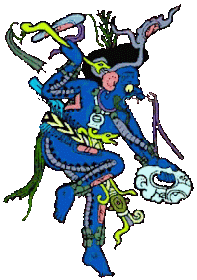Please allow me to share some of the ancient Mayan belief system concerning the rain ceremonies with you today. Its source is About.com
Chaac
The Mesoamerican rain god was known as Cocijo by the Zapotec of Oaxaca, as Tlaloc by the Aztec in Central Mexico and as Chaac (with variant spellings such as Chac and Chaahk) among the ancient Maya.
Chaac was the god of rain, lightning and storms and is often represented holding axes and snakes that he uses to hit the clouds to produce rain. He was helped in his duties by dwarfs. His actions assured the growth of maize and vegetation in general as well as natural cycles of life. Natural events of different intensities from the vivifying rain, and storms, to the more dangerous and destructive hailstorms and hurricanes were considered manifestations of the god.Characteristics of the Mayan Rain God.
For the ancient Maya, the rain god had a particularly strong relationship with rulers, because—at least for the earlier periods of Maya history—rulers were considered rainmakers, and in later periods, were able to communicate and intercede with the gods. The alter-ego of Maya shamans and rulers, whose roles often overlapped, especially in the Preclassic period, were in fact able to reach the inaccessible places where the rain gods dwelled, and intercede with them for the people.
According to Maya cosmology, Chaac was also linked to the four cardinal directions. Each world direction, in fact, was connected with one aspect of Chaac and a specific color:
Chaak Xib Chaac, was the Red Chaac of the East
Sak Xib Chaac, the White Chaac of the North
Ex Xib Chaac, the Black Chaac of the West, and
Kan Xib Chaac, the Yellow Chaac of the South.
Sak Xib Chaac, the White Chaac of the North
Ex Xib Chaac, the Black Chaac of the West, and
Kan Xib Chaac, the Yellow Chaac of the South.
These were the Chaacob (plural for Chaac) and were worshipped as deities in many parts of the Maya area, especially in Yucatan. Chaac Iconography
Even though Chaac is one of the most ancient Maya deities, we have representations of the god only from the Classic and Postclassic period. Most of the images depicting the rain god are on Classic period painted vessels and Postclassic codices. As for many Maya gods, Chaac is portrayed as a human but with animal characteristics.
He has reptilian attributes and fish scales, a curly nose and protruding lower lip. He holds a stone axe used to produce lightning and wears an elaborate headdress.
Chaac Ceremonies
Ceremonies in honor of the rain god were held in each Maya city and at different levels of society. Rituals to propitiate rain took place in the agricultural fields, as well as in more public settings.
Chaac Ceremonies
Ceremonies in honor of the rain god were held in each Maya city and at different levels of society. Rituals to propitiate rain took place in the agricultural fields, as well as in more public settings.
Sources
This glossary entry is a part of the About.com guide to the Maya civilization, and the Dictionary of Archaeology.
Miller, Mary and Karl Taube, 1993, The Gods and Symbols of Ancient Mexico and the Maya: An Illustrated Dictionary of Mesoamerican Religion. London, Thames and Hudson.
Sharer, Robert J., and Loa P. Traxler, 2006, The Ancient Maya. Sixth Edition, Stanford University Press, Stanford, California.
More about the Ancient Maya
Guide to the Maya Civilization
The Ancient Maya or Mayans?
Ancient Maya Bloodletting Rituals
More Mesoamerican Gods
Ix Chel (Maya Moon Goddess)
Tlaloc, the Aztec Rain God--
This glossary entry is a part of the About.com guide to the Maya civilization, and the Dictionary of Archaeology.
Miller, Mary and Karl Taube, 1993, The Gods and Symbols of Ancient Mexico and the Maya: An Illustrated Dictionary of Mesoamerican Religion. London, Thames and Hudson.
Sharer, Robert J., and Loa P. Traxler, 2006, The Ancient Maya. Sixth Edition, Stanford University Press, Stanford, California.
More about the Ancient Maya
Guide to the Maya Civilization
The Ancient Maya or Mayans?
Ancient Maya Bloodletting Rituals
More Mesoamerican Gods
Ix Chel (Maya Moon Goddess)
Tlaloc, the Aztec Rain God--
Have a beautiful day










No comments:
Post a Comment